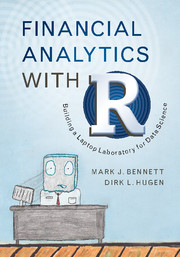Book contents
- Frontmatter
- Dedication
- Contents
- Preface
- Acknowledgments
- 1 Analytical Thinking
- 2 The R Language for Statistical Computing
- 3 Financial Statistics
- 4 Financial Securities
- 5 Dataset Analytics and Risk Measurement
- 6 Time Series Analysis
- 7 The Sharpe Ratio
- 8 Markowitz Mean-Variance Optimization
- 9 Cluster Analysis
- 10 Gauging the Market Sentiment
- 11 Simulating Trading Strategies
- 12 Data Exploration Using Fundamentals
- 13 Prediction Using Fundamentals
- 14 Binomial Model for Options
- 15 Black–Scholes Model and Option-Implied Volatility
- Appendix Probability Distributions and Statistical Analysis
- References
- Index
8 - Markowitz Mean-Variance Optimization
Published online by Cambridge University Press: 20 October 2016
- Frontmatter
- Dedication
- Contents
- Preface
- Acknowledgments
- 1 Analytical Thinking
- 2 The R Language for Statistical Computing
- 3 Financial Statistics
- 4 Financial Securities
- 5 Dataset Analytics and Risk Measurement
- 6 Time Series Analysis
- 7 The Sharpe Ratio
- 8 Markowitz Mean-Variance Optimization
- 9 Cluster Analysis
- 10 Gauging the Market Sentiment
- 11 Simulating Trading Strategies
- 12 Data Exploration Using Fundamentals
- 13 Prediction Using Fundamentals
- 14 Binomial Model for Options
- 15 Black–Scholes Model and Option-Implied Volatility
- Appendix Probability Distributions and Statistical Analysis
- References
- Index
Summary
This chapter focuses on an applied statistical approach to the data mining of equities, price trends in order to gain insight into selecting the most desirable portfolios on the basis of return, volatility, and inter-security time series correlation. Historical prices can very well tell the story of the times of the data collection: volatile, trending bullish or bearish, oscillating or crashing, based upon what market events have occurred. Figure 3.3 shows the price behavior of several stocks with the Great Recession in the early portion of the charts. Generally, some securities are very sensitive to the events of the times while others manifest a higher degree of independence. In any case, the simulations ensure that each security is treated analytically according to its historical nature.
Classically, when analyzing desirable equities portfolios, one can focus on two very different approaches. They are
• fundamental analysis of company balance sheets, which can involve factors for book equity to market equity ratios, etc. (Fama and French, 1995, 1996); or
• the price behavior of their common stock in the global market (Markowitz, 1952, 1959; Ruppert, 2011).
In later chapters we will consider the former analysis, but in our financial analytics experiment in this chapter, we choose the latter, which is consistent with the approach of many market practitioners. The raw price behavior of the common stock is recorded and can be observed and obtained by participants worldwide. The publicly available price data is the driver. The theory surrounding the analysis of the prices in portfolios began in the 1950s.
Depending upon the return and volatility of the historical prices, as well as the covariance of an individual security to the remaining securities, preference is given to those with higher return and lower volatility and lower covariance.
Optimal Portfolio of Two Risky Assets
The basic idea of a portfolio is to place a set of securities into a basket with weights representing the amount of investment in each. Each investment return is a random variable. In the case of two investment returns, X and Y, if a and b are the investment weights, we are interested in how the variance of the portfolio turns out.
- Type
- Chapter
- Information
- Financial Analytics with RBuilding a Laptop Laboratory for Data Science, pp. 157 - 196Publisher: Cambridge University PressPrint publication year: 2016



